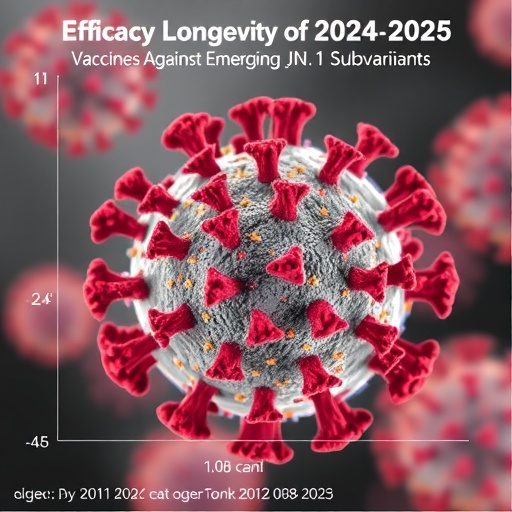The ongoing global battle against COVID-19 has entered a new chapter with the introduction of the updated 2024-2025 vaccines, which are showing promising results in providing substantial protection, particularly against severe manifestations of the disease. Recent research emerging from a study published in a prestigious medical journal details the effectiveness of these vaccines, shedding light on their capacity to neutralize various subvariants of the virus, a concern that has fueled much debate since the pandemic’s early days.
The study meticulously examined the immunological response elicited by the revamped vaccine formulations, a crucial factor given the virus’s notorious ability to mutate, creating variants that can partially evade immune defenses. These vaccines, tailored to target predominant subvariants circulating globally, have been tested in diverse populations to assess their real-world effectiveness. Initial findings reveal that while the vaccines significantly reduce the risk of severe disease—such as hospitalizations and critical care admissions—their protective benefits tend to diminish over time, underscoring the importance of timely booster doses.
From a virological perspective, the updated vaccines appear to generate a robust adaptive immune response, predominantly stimulating neutralizing antibodies and T-cell responses that are essential for viral clearance. This broad immunological engagement is critical in countering the multiple spike protein alterations present in Omicron subvariants and others. Strikingly, the vaccine efficacy was observed to be comparable across different subvariant infections, suggesting a growing resilience in vaccine design strategies that aim to confer a wide breadth of protection.
One of the pivotal technical aspects of this investigation involved longitudinal monitoring of antibody titers post-vaccination. These measurements revealed a peak in neutralizing antibodies shortly after vaccination, followed by a gradual waning, which correlates with reduced clinical protection against mild to moderate infections. However, the sustained cellular immunity might explain the retained efficacy against severe disease, a finding that aligns with the immunological principles of memory T-cell mediated response long after antibody levels decline.
The analytical approach adopted in the research entailed sophisticated genomic surveillance to classify infecting viruses into distinct subvariants, coupled with immunoprofiling techniques. This comprehensive methodology allowed the researchers to parse out the differential vaccine impact with respect to each subvariant, delivering invaluable insights to public health policymakers regarding vaccination schedules and booster recommendations.
Moreover, this research highlights the dynamic challenge faced by vaccine developers dealing with a rapidly evolving viral pathogen. The need to update vaccine compositions seasonally is reminiscent of the influenza vaccine strategy, marking a potential paradigm shift in how coronaviruses are managed moving forward. Such updated vaccines represent a critical advancement in preemptive health measures, substantially reducing the disease burden and healthcare system strain worldwide.
In the broader context of vaccine science, the findings reinforce the concept that while sterilizing immunity—complete prevention of infection—is difficult to achieve against swiftly mutating respiratory viruses, moderate to high effectiveness against severe outcomes is a realistically attainable and immensely valuable target. Maintaining this level of protection can dramatically decrease mortality rates and the societal impact of COVID-19.
The work also underscores a critical intersection of epidemiology, immunology, and molecular biology, where collaboration across disciplines enables rapid vaccine adaptation in response to viral evolution. This multidisciplinary nexus has accelerated the translation of genomic data into actionable vaccine updates, which is a model that could extend to other infectious diseases facing similar mutational challenges.
Engagement with real-world vaccine effectiveness studies, such as this one, is essential for adapting global vaccination strategies, particularly in the face of vaccine hesitancy and the ongoing emergence of new variants. Continued surveillance and transparent dissemination of data empower health authorities to make informed decisions grounded in empirical evidence rather than speculation.
Concluding, the updated 2024-2025 COVID-19 vaccines provide a robust line of defense against a mutable adversary, with demonstrated efficacy in mitigating the most severe consequences of infection. The waning immunity observed signals a need for vigilance and possibly periodic booster inoculations to sustain protection across populations, especially in vulnerable groups. The equivalence of efficacy across diverse subvariants instills a cautious optimism about the trajectory of vaccine innovation amid the evolving pandemic.
As this pivotal study lifts the veil on next-generation vaccine effectiveness, it marks a hopeful advancement not only in managing the COVID-19 pandemic but also in fortifying our preparedness against future viral threats. The adaptive nature of these vaccines, combined with cutting-edge molecular monitoring, exemplifies the sophistication and responsiveness of modern vaccinology.
Subject of Research: Effectiveness of updated 2024-2025 COVID-19 vaccines against severe disease and viral subvariants.
Article Title: Not provided.
News Publication Date: Not provided.
Web References: Not available.
References: (doi:10.1001/jamainternmed.2025.5465)
Image Credits: Not provided.
Keywords: COVID-19 vaccines, COVID-19, Disease prevention, Internal medicine
Tags: adaptive immune response in COVID-19 vaccines.COVID-19 vaccine efficacy 2024-2025effectiveness of updated COVID-19 vaccinesemerging COVID-19 variants challengesglobal vaccination strategies against COVID-19immunological response to vaccinesJN.1 subvariants protectionneutralizing antibodies and T-cell responsesreal-world effectiveness of COVID-19 vaccinessevere disease risk reduction from vaccinestailored vaccines for viral mutationsvaccine longevity and booster importance





